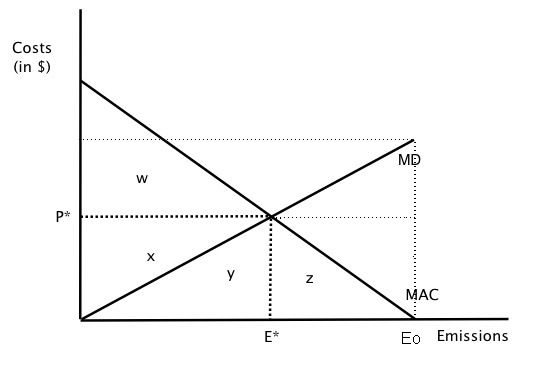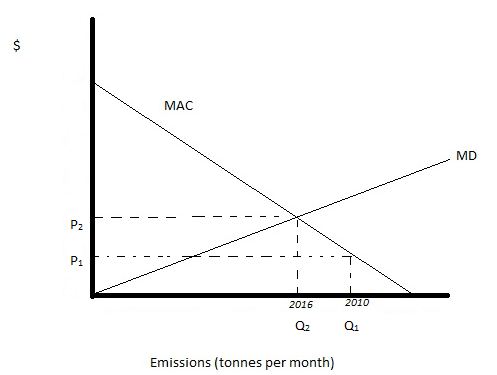Course:ECON371/UBCO2010WT1/GROUP4/Article 2: Canada and U.S. Unite on Car Emission Standards
Article: http://www.cbc.ca/canada/story/2010/04/01/vehicle-emissions-ottawa-washington.html
Summary
Primarily, this news article is concerned with the new rules which mean Canada and the U.S. will have uniform emissions standards for the cars and light trucks which will be produced in the future. Environment Minister Jim Prentice announced this fact in an Ottawa-area news conference.
The goal is that by 2016, the new measures will help reduce greenhouse gas emissions from vehicles by 25%. The new standards will require the 2016 model-year vehicles to meet a fuel efficiency target of 35.5 miles per gallon or 6.6 L/100 km. This is figure is combined for cars and trucks, and is an increase of nearly 10 miles per gallon over current standards. The article also stated that the current average Canadian car consumes 8.6 liters of fuel in 100 kilometers. Prentice also mentioned, “This is taking a big step forward in fighting climate change.”
Furthermore, it is known that emissions from passenger vehicles represent 25% of Canada’s total emissions. This means that automobiles of all sizes will have to be proportionately more fuel-efficient. An important thing to note is that these new standards are likely to lead to an increase in the sticker prices of vehicles. Although this is the case, drivers will be able to make up the difference in price with lower fuel consumption costs within a year and a half of buying the car, and will benefit from the savings soon after.
Later on in the article, it mentions what President Barack Obama had to say regarding the new standards. He stated, the new standards would “reduce our dependence on oil while helping folks spend a little less at the pump.” He also mentioned that the increased efficiency would save 1.8 billion barrels of oil over the life of the program. Only time will tell as to how effective the new standards will turn out to be.
Analysis
Based on the article, as cars are produced according to the new standards, the sticker prices will be rise above the point that they are at today. The new prices are shown by point MC2 in the first graph. As a result of the increased cost to producers in building the new automobiles, the marginal cost increases and therefore, shifts from MC1 to MC2. Another result is a price move P1 to P2. Due to this increase in price, quantity demanded will thus fall from Q1 to Q2.
Under the new standards the consumer will be face with a higher upfront cost for the automobile, however, over the long run they will end up recovering the increased cost and move toward higher savings due to the increased fuel efficiency of their vehicles.
Currently, the automobile market is at a point resembling the 2010 point at Q1 and P2. As the year 2016 approaches, and as the new standards move into place, the market will be move to the efficient point of Q2 and P2. At this point, there is an increase in the marginal abatement costs, but a reduction in emissions. The cost increase comes as a result from the change in technology that is required to produce the more efficient auto parts, these parts are will be necessary to meet new emission standards. The increase in cost will also come from enforcing the new regulations after the introduction of the more efficient vehicles to the public.
Conclusion
This article argues that if standards are increased and the levels of emissions are reduced, it will significantly impact and decrease the 25% of total emissions that result from passenger vehicles in Canada. The lower vehicle emissions would definitely create a noticeable difference in environmental quality. Also, as the efficiency goes up, there would be less dependence on fuel; as Obama put it, a decrease of 1.8 barrels over the life of the program. Hopefully other nations, in addition to Canada and the United States, end up changing their regulations and standards regarding vehicle emissions. Although 2016 is a few years down the road, the results of all of the new parts will definitely be pleasing. All in all, automobile manufacturers are moving in a positive direction when it comes to the environment.
Prof's Comments
What type of regulation is this? Command and control or incentive based? Emissions come from driving. Tighter fuel efficiency standards don't impact on the amount of driving. If vehicles are more fuel efficient, then the marginal cost of each kilometer driven will be lower. How will this affect the amount driven? The auto companies are happy because they have only one standard to adhere too. It is costly for them to offer multiple models in different markets. However, nobody forces them to offer multiple models. If it is cheaper for them to produce only one type of car, the one that satisfies the strictest standard, then they will do so. If California set that standard, is it possible that by joining the continental standard, overall emissions from vehicles will be higher than they would have been if California had continued to be a leader?
== Conclusion ==

